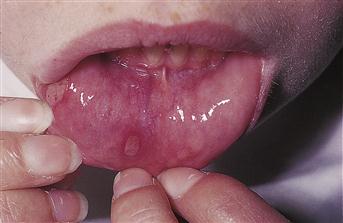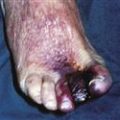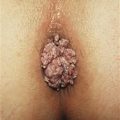Mouth Ulcers
Ulceration in the mouth is common. It is important to be able to distinguish between simple benign ulcers, e.g. traumatic or aphthous, and those that are malignant. Tongue lesions are dealt with on p. 463.
History
Traumatic
Diagnosis usually obvious, such as ill-fitting dentures or sharp teeth and ulcers heal when the precipitating cause is removed.
Aphthous
Patient presents with small, painful ulcers, usually inside the cheeks or lips. They heal in about one week but others may occur while the initial ulcers are healing. A number of patients will have a history of gastrointestinal disease, e.g. coeliac disease or Crohn’s disease. They may also arise in patients with debilitating disease.
Inflammatory
Chronic granulomatous disease (Crohn’s) may affect the oral cavity. The patient may complain of painful ulcers, swelling of the lips or gum swelling.
Infective
Vincent’s angina (acute ulcerative stomatitis) presents with swollen gums with small ulcers, which may spread to the buccal mucosa. The patient will complain of bleeding gums, together with constitutional upset with fever and malaise. Syphilis is now rarely seen but chancres, snail-track ulcers and gummas may occur within the mouth. Candida is not uncommon in the oral cavity. There may be a history of debilitating disease, diabetes or immunosuppressive therapy. Herpes simplex presents as painful vesicles, which ulcerate. The patient may be immunocompromised. Herpes zoster may occur on the palate in the distribution of the maxillary division of the trigeminal nerve. There will be severe pain and ulceration.
Neoplastic
Squamous cell carcinomas occur as ulcers with hard edges, which bleed. They tend to occur in the older patient. There may be a history of leucoplakia or the six Ss: syphilis, smoking, sharp tooth, spirits, spices, sepsis.
Haematological disorders
Agranulocytosis may be due to drugs or marrow infiltration. Take a careful drug history. The ulceration may be due to bacterial infection consequent on the low WCC. Leukaemia may also present with mouth ulcers.
Skin disease-associated
These include lichen planus, pemphigus pemphigoid and bullous erythema multiforme. The reader is referred to a textbook of dermatology for the characteristics of these conditions.
Connective tissue disease
Oral ulceration may be associated with SLE. The patient may present with other features of this disease, e.g. skin lesions, joint pains or renal failure.
Other
Although Behçet’s disease may present with mouth ulcers, the patient may also complain of arthritis, eye disease, scrotal or labial ulcers. With Reiter’s disease, the patient will also complain of urethritis, conjunctivitis and arthritis. There will usually be a history of sexual contact.
Examination
Traumatic
There will be ulceration related to ill-fitting dentures or sharp teeth. Observe for healing when the precipitating cause has been removed.
Aphthous
Small, white, circular, deep, painful ulcers with surrounding erythema. There may be signs and symptoms of gastrointestinal disease or other debilitating disease, or they may occur in otherwise healthy patients.
Inflammatory
With Crohn’s disease, there may be lip swelling, nodular thickening of the buccal mucosa, diffuse granular gingival swelling or painful linea oral ulcers.
Infective
Vincent’s angina presents with red, swollen, bleeding gums covered with yellowish ulcers. The ulcers may also be seen on the buccal mucosa and occasionally on the tonsils. There is usually tender lymphadenopathy. With syphilis, there may be a chancre, snail-track ulcers or gummas. Herpes simplex presents with small 2-mm vesicles, which ulcerate and coalesce and produce erosions with surrounding erythema. Herpes zoster shows small ulcers surrounded with erythema in the distribution of the maxillary nerve on the palate. There will usually be skin lesions in the distribution of the nerve. Candidiasis appears as red patches on the buccal mucosa, which are covered with white patches of desquamated epithelium mixed with fungus.
Neoplastic
There will be an ulcer with hard, everted edges which bleeds on touching. Cervical lymphadenopathy may be present.
Haematological disorders
These present with bleeding gums and ulceration.
Skin disease-associated
The reader is referred to a textbook of dermatology for the characteristic features of these.
Connective tissue disorders
Oral ulceration may occur with SLE. Other features may be present on examination, e.g. skin, joint or renal disease.
Other
Behçet’s disease presents with painful ulcers. Other features may be apparent on examination, e.g. arthritis, keratitis, iritis, scrotal or labial ulcers. With Reiter’s syndrome, there will be urethritis, conjunctivitis and balanitis, as well as mouth ulcers.
General Investigations
■ FBC, ESR
Hb ↓ malignancy, debilitating disease. WCC ↑ infection, leukaemia. ESR ↑ malignancy, connective tissue disease, chronic infection, e.g. syphilis.
■ Swab
C&S. Infections – Borrelia vincentii (Vincent’s angina), candidiasis.
■ Antibody screen
SLE – ANA positive. Anti-double-stranded DNA ↑.





